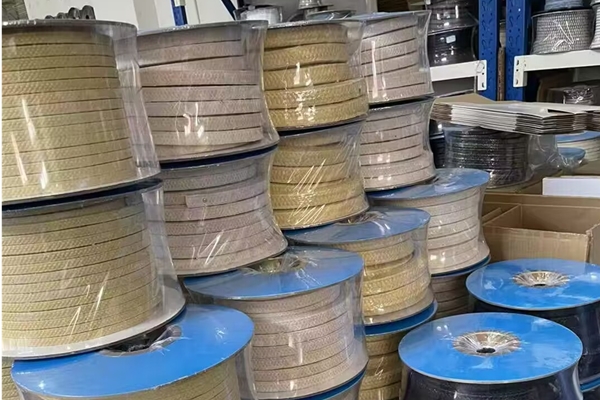Swelling: The phenomenon where rubber parts absorb liquid and become soft and swollen when their oil resistance, chemical resistance, etc., are not suitable.
Retaining Ring: Used to prevent the overflow of rubber parts under high-pressure conditions. The installation position should be on the opposite side of the pressurized side. When pressure is applied on both sides, the retaining ring should be installed on both sides of the rubber parts. Additionally, in low-pressure conditions where overflow is not likely to occur, it can also prevent tearing, torsional damage, and other accidents, thus avoiding breakage and extending the lifespan of the rubber parts. Materials include leather, nylon, hard rubber, metal, and Teflon, but Teflon retaining rings with good compatibility are mostly used nowadays. There are three types: ring-shaped, oblique cut, and spiral. In terms of usage effect, the ring-shaped is best, but considering assembly, the oblique cut and spiral types are mostly used.
Elasticity: The property of a material to return to its original shape after the load causing deformation is removed. The property of not being able to return to the original shape is called “plasticity”.
Parting Line: The line texture where the mold closes.
MSDS: Stands for Material Safety Data Sheet, also known as the “product safety data sheet”. It records information such as the names of substances in the product, their hazardous properties, usage precautions, and environmental impacts for the safe and proper use of chemical products.
Wire Diameter: Indicates the thickness of the rubber parts. It is also expressed using symbols such as W and π.
Inner Diameter: Indicates the inner diameter of the rubber parts. It is also expressed using symbols such as ID.
Fixation Methods: Generally, there are three fixation methods: for motion, for cylindrical surface fixation, and for planar fixation.
Abrasion Resistance: The property of not being easily worn away when rubber, being soft, is rubbed against other materials, causing volume reduction.
Non-Adhesion: The property of rubber parts that do not stick to the material of the opposite surface even after prolonged use.
Test Report: A table showing the physical properties and specifications of the rubber parts.
Hardening: Sometimes, unreacted vulcanizing agents remain in the rubber, which continues vulcanizing upon heating, increasing hardness. This is called “hardening”. However, under prolonged high temperatures or rapid temperature rise, the rubber will harden rapidly, losing its softness, and molecular bonds will break, causing cracks or even damage. (Depending on the type of rubber, sometimes molecular chains may break and soften.)
Ozone Cracking: Ozone, being a highly oxidizing gas, promotes the breaking and cross-linking of rubber polymer chains upon exposure, causing rubber degradation (reduction in molecular weight decreases strength, and hardening decreases flexibility). As degradation progresses, the surface will develop cracks known as “ozone cracking”.
Rubber Parts: These are ring-shaped seals with an O-shaped cross-section. They are generally installed in grooves and moderately compressed to serve as seals for various fluids such as oil, water, air, and gas. Depending on the usage method, there are types of fixation and motion.
Compression Allowance: Rubber parts are usually used in a compressed state, so the groove depth is set slightly smaller than the thickness of the rubber parts. This compression amount is called “compression allowance”.
Torsion Phenomenon: Torsion of rubber parts caused by incorrect installation, poor machining of sliding surfaces, or valve opening and closing actions. In some cases, it may even result in cutting.
Coating: Refers to applying a fluororesin or other coating on the surface of rubber parts to improve sliding properties.
JASO Standards: Refers to the standards set by the Japanese Automotive Standards Organization. The tolerances for wire diameter and inner diameter are very strict under JIS standards.
Permeability: The property of gas molecules passing through intermolecular spaces is called “permeability”. Conversely, the property of not easily passing through is called “gas impermeability”. Rubber, being elastic, has a less dense molecular structure compared to plastic, making it generally more permeable than plastic. This varies with the material; for inorganic gases (N2, O2, He, etc.), butyl rubber and fluoro rubber are less permeable, while silicone rubber is more permeable.
Rubber: A material that extends significantly with a small force applied and returns to its original shape after the force is removed (elasticity), requiring a cross-linking reaction. There is natural rubber made from latex collected from rubber trees, synthetic rubber made from chemical synthesis from petroleum, and reclaimed rubber. Rubber that does not require cross-linking and can be molded like plastic is called “thermoplastic elastomer”.
Flash: Thin rubber that flows out from the gaps in the mold assembly. The amount of flash on rubber parts is specified in JIS B2408.
Compression Set: The permanent deformation rate of rubber after bearing a compressive load for a long time. It is important not to confuse this with a low-temperature compression set.




